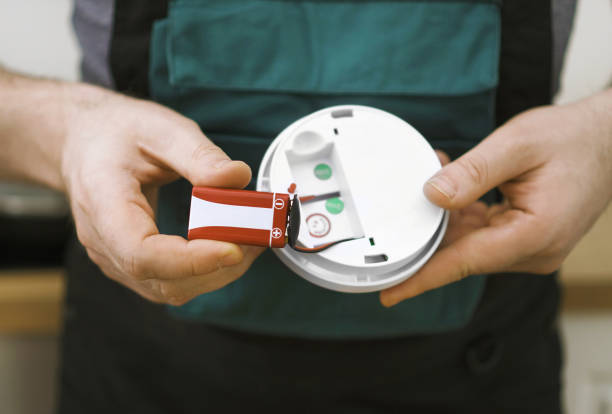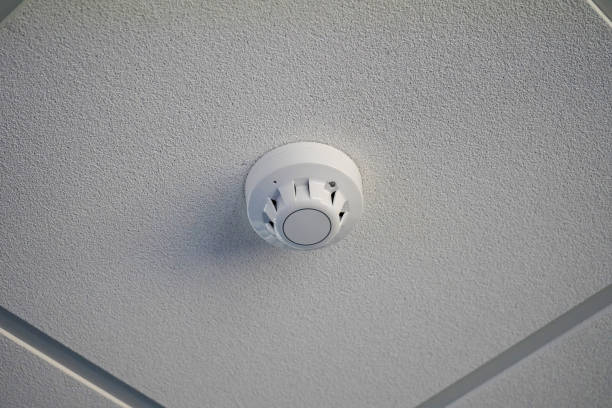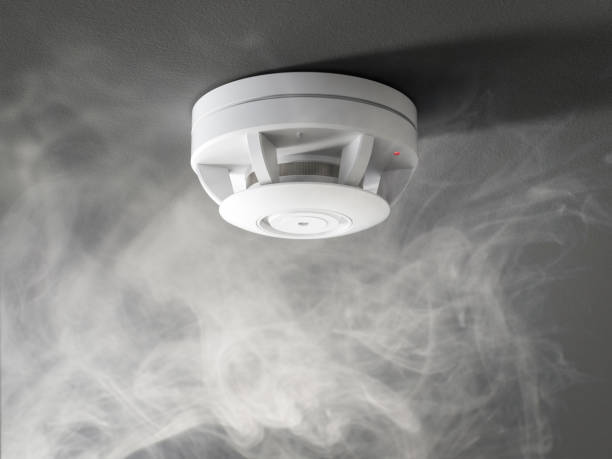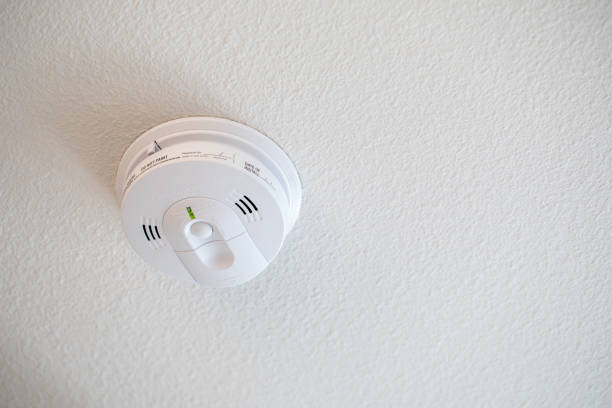Is your smoke detector still chirping even after you’ve replaced the batteries? You’re not alone in this frustrating experience. This comprehensive guide will help you understand why this happens and how to fix it.
The Midnight Mystery: Why Won’t That Beeping Stop?
It’s 2 AM. You’ve replaced the battery in your smoke detector, yet that persistent chirp continues to echo through your home every 30 seconds. You’re not imagining things—this is a common issue that homeowners face across America.
The National Fire Protection Association reports that over 25% of residential fire fatalities occur in homes with non-functioning smoke alarms. Often, homeowners disable beeping detectors out of frustration, leaving their homes unprotected. Understanding why your smoke detector continues to beep even with a new battery isn’t just about restoring peace and quiet—it’s about maintaining the safety of your home and loved ones.
Real User Experience: “I was ready to throw my smoke detector out the window after it kept chirping despite three different new batteries. Turns out, it was dust in the sensing chamber all along!” — Michael T., Chicago homeowner
7 Common Reasons Your Smoke Detector Beeps Even With New Batteries

1. Residual Electrical Charge
Smoke detectors are designed with capacitors that store electrical charge. Even after battery removal, these capacitors can retain enough power to cause continued chirping. This design feature ensures your detector can still alert you during power interruptions, but it can be maddening when you’re trying to silence the device.
Solution: After removing the old battery, press and hold the test button for 15-20 seconds. This action discharges any residual electricity in the device’s capacitor, essentially “resetting” the detector. Then install your new battery and see if the chirping stops.
2. Incorrect Battery Installation
Even the most careful homeowners can occasionally install batteries incorrectly. Smoke detectors have specific polarity requirements (positive/negative orientation), and incorrect placement can trigger warning beeps.
Solution: Remove the battery and double-check the polarity markings inside the battery compartment. Ensure that the positive (+) and negative (-) ends of the battery align with the corresponding markings in the detector.
3. Battery Terminal Connection Issues
Sometimes the problem isn’t the battery itself but the connection between the battery and the detector. Dust, corrosion, or manufacturing defects can interfere with proper electrical contact.
Solution: Remove the battery and inspect the terminals for any signs of corrosion or dust buildup. Gently clean the contacts with a dry cloth or, for corrosion, use a small amount of white vinegar on a cotton swab. Allow the contacts to dry completely before reinstalling the battery.
4. Poor Battery Quality or Wrong Type
Not all batteries are created equal. Using low-quality or incorrect battery types can lead to premature chirping even when the batteries are new.
Solution: Always use high-quality batteries from reputable manufacturers. Most smoke detectors perform best with alkaline batteries rather than rechargeable ones. Check your detector’s manual for specific battery recommendations.
As the Battery Industry Association notes, “Alkaline batteries consistently outperform other types in smoke detectors due to their stable discharge patterns and longer shelf life.”
5. Dust or Insect Interference
Over time, dust and small insects can enter your smoke detector and interfere with its sensing chamber. This contamination can trigger false alarms or continuous beeping.
Solution: Use compressed air to gently blow out any dust or debris from the detector’s vents. Be careful not to blow too hard, as this could damage sensitive components inside the detector.
According to John Smith, a fire safety engineer with 15 years of experience: “I’ve seen everything from spider webs to small insect eggs inside smoke detectors. Even a small amount of dust can trick the sensor into thinking there’s smoke present.”
6. End of Life Warning
Smoke detectors are designed to last about 8-10 years. As they approach the end of their operational life, many models will begin chirping to alert you that replacement is needed—regardless of battery status.
Solution: Check the manufacturing date printed on the back or inside of your detector. If it’s approaching or past the 10-year mark, it’s time for a replacement. No amount of battery changing will silence an end-of-life warning.
7. Hardwired System Issues
If your smoke detector is part of an interconnected, hardwired system, the chirping might not be coming from the detector you’ve just replaced the battery in. In interconnected systems, one malfunctioning detector can trigger alerts in all units.
Solution: If you have hardwired detectors, turn off the power to the circuit at your breaker box before troubleshooting. Then check each detector in the system to identify which one is causing the problem. Sometimes replacing one battery prompts you to replace all batteries in an interconnected system.
Real User Experience: “After three sleepless nights, I finally realized the chirping was coming from my hallway detector, even though I’d replaced the battery in my bedroom unit. Once I changed all batteries in the system, blessed silence returned!” — Jennifer K., Florida
Step-by-Step Guide to Silence That Stubborn Beep

Step 1: Complete Power Reset
- Remove the detector from its mounting bracket
- Remove the battery
- For hardwired models, disconnect from the wiring harness
- Press and hold the test button for at least 15 seconds
- Leave the detector without power for at least 8 hours (overnight)
This extended reset allows any residual power to completely drain, effectively “rebooting” the detector’s internal circuitry.
Step 2: Proper Battery Replacement
When reinstalling batteries, follow these best practices:
- Use only fresh, high-quality batteries from reputable brands
- Check expiration dates on battery packaging
- Never mix old and new batteries or different battery types
- Ensure proper polarity alignment
- Make sure the battery compartment closes completely and securely
Step 3: Clean the Unit
Gentle cleaning can resolve many beeping issues:
- Use compressed air to blow out dust from sensing chambers and vents
- Clean battery contacts with a pencil eraser or cotton swab with vinegar
- Wipe the exterior with a slightly damp cloth to remove dust buildup
- Allow the unit to dry completely before reinstalling
Step 4: Reset the Detector
Most modern smoke detectors have reset functionality:
- Install fresh batteries
- Press and hold the test/reset button (usually for 10-15 seconds)
- Listen for a confirming beep or chirp pattern that indicates successful reset
Step 5: Test Functionality
After resolving the beeping issue, always verify that your detector is working properly:
- Press the test button until the alarm sounds
- The alarm should be loud and clear
- For interconnected systems, verify that all detectors sound when one is tested
When to Replace Rather Than Repair
Sometimes, attempting to silence a persistent beep is futile. Consider replacement in these scenarios:
Age of the Detector
The National Fire Protection Association (NFPA) recommends replacing smoke detectors every 10 years, regardless of apparent functionality. The date of manufacture is typically printed on the back or inside of your detector.
“Smoke detectors contain sensing technologies that degrade over time,” explains fire safety expert Dr. Sarah Johnson. “After a decade, even detectors that seem functional may have significantly reduced sensitivity to smoke particles.”
Frequent False Alarms
If your detector regularly triggers false alarms even after cleaning and battery replacement, it may have a faulty sensor that cannot be repaired.
Physical Damage
Cracks, water damage, or discoloration of the detector housing indicate potential internal damage that compromises safety.
Outdated Technology
Older ionization-only detectors are less effective at detecting slow, smoldering fires. Modern dual-sensor detectors provide superior protection against both fast-flaming and smoldering fires.
Real User Experience: “My detector wouldn’t stop beeping despite trying everything. When I checked the date, I realized it was 12 years old! The new model I installed hasn’t given me a single problem.” — Robert M., Texas homeowner
Types of Smoke Detectors and Their Battery Requirements
Understanding your detector type helps address battery-related issues more effectively:
Ionization Smoke Detectors
These contain a small amount of radioactive material that ionizes the air, creating an electrical current that flows between two plates. Smoke disrupts this current, triggering the alarm.
Battery needs: These typically draw more current and may require battery replacement more frequently, around every 6-9 months.
Photoelectric Smoke Detectors
These use a light beam and a photosensor. When smoke enters the chamber, it scatters the light beam, directing it toward the sensor and triggering the alarm.
Battery needs: Generally more energy-efficient, with batteries lasting 8-12 months.
Dual-Sensor Smoke Detectors
These combine both ionization and photoelectric technologies for comprehensive protection.
Battery needs: Due to powering two sensing technologies, these may require battery replacement every 6 months.
Smart Smoke Detectors
These connect to your home’s Wi-Fi network, sending alerts to your smartphone when triggered and often integrating with home automation systems.
Battery needs: Most use lithium batteries that last 2-5 years, but the Wi-Fi connectivity draws additional power. Many smart models like Nest Protect provide battery level indicators through their companion apps.
Seasonal Battery Replacement Strategy
Fire safety experts recommend a systematic approach to smoke detector maintenance:
The Daylight Saving Time Rule
Replace all smoke detector batteries when you adjust your clocks for daylight saving time—twice yearly. This simple habit ensures regular maintenance.
The Battery Rotation System
Keep a small stock of batteries specifically for smoke detectors. Use a permanent marker to date batteries when purchased, and always use the oldest stock first to maintain freshness.
The Full-System Check
Twice yearly:
- Replace all batteries
- Test all detectors
- Clean all units
- Check manufacturing dates
- Update your home evacuation plan
According to the American Red Cross, this comprehensive approach dramatically reduces the risk of smoke detector failure during emergencies.
Battery Selection Guide
Not all batteries perform equally in smoke detectors. Consider these factors when selecting batteries:
Chemistry Matters
- Alkaline batteries: Most commonly recommended for smoke detectors; provide reliable power for 6-12 months
- Lithium batteries: Last longer (up to 5 years) but are more expensive; excellent for hard-to-reach detectors
- Rechargeable batteries: Generally NOT recommended due to faster self-discharge rates and voltage characteristics
Brand Reliability
Independent testing consistently shows that major brands like Energizer, Duracell, and Rayovac outperform generic batteries in smoke detectors, particularly in low-temperature environments.
Environmental Considerations
Battery performance varies with environmental conditions:
- Cold attics may reduce battery life by 50%
- Humid bathrooms can accelerate corrosion
- Kitchens with frequent temperature changes may reduce battery efficiency
For more detailed information on selecting the right batteries for your specific smoke detector model, visit our comprehensive Battery Guide.
Special Considerations for Hardwired Systems
Hardwired smoke detectors present unique challenges when beeping persists after battery replacement:
Backup Battery Purpose
In hardwired systems, batteries serve as backup power sources during electrical outages. However, they still trigger low-battery warnings when depleted.
System Interconnection
When one detector in an interconnected system detects a problem, all units may sound the alarm. This means:
- The beeping detector may not be the one with the issue
- Multiple detectors may need battery replacement simultaneously
- System reset procedures often differ from standalone detectors
Power Cycling Procedure
To properly reset a hardwired system:
- Turn off power at the circuit breaker
- Remove all detector batteries
- Press and hold test buttons on each unit for 15-20 seconds
- Leave the system without power for 15 minutes
- Restore power at the circuit breaker
- Install fresh batteries in all units
Real User Experience: “Our entire hardwired system kept chirping randomly after replacing batteries. The electrician found that one unit had a failing sensor that was triggering the entire network. Replacing just that one detector solved everything.” — The Martinez Family, California
Environmental Factors Affecting Battery Performance

Several environmental factors can cause premature battery drainage or performance issues in smoke detectors:
Temperature Fluctuations
Extreme temperature changes can significantly reduce battery life. Detectors installed in attics, garages, or near exterior walls may experience:
- Accelerated battery drain during cold winter months
- Possible voltage instability during rapid temperature changes
- Reduced overall battery lifespan
Humidity Levels
High humidity environments like bathrooms can:
- Cause corrosion on battery terminals
- Allow moisture to enter the detector housing
- Create condensation that interferes with electronic components
Electrical Interference
Nearby electrical devices or wiring problems can sometimes cause:
- Phantom power drains on batteries
- Interference with detector sensors
- Erratic behavior including unexplained beeping
When dealing with a smoke detector that beeps with new battery, checking environmental conditions can help identify factors that may be affecting its performance.
Professional Assessment and Installation
While DIY troubleshooting can resolve many issues, some situations warrant professional intervention:
When to Call a Professional
Consider consulting a fire safety professional or licensed electrician if:
- Multiple detectors continue beeping after following all troubleshooting steps
- You notice visible damage or unusual behavior from your detectors
- Your home has outdated or improperly installed detection systems
- Local building codes require professional certification
Professional Installation Benefits
Professional installation offers several advantages:
- Optimal placement for maximum protection
- Proper interconnection of multiple units
- Integration with home security systems
- Compliance with local fire safety codes
According to First Alert, a leading manufacturer of home safety products, professional installation can significantly improve detection response times during actual emergencies.
Innovative Solutions for Persistent Problems
If you’ve tried everything and still face beeping issues with new batteries, consider these advanced solutions:
Alternative Power Sources
Some newer detector models offer alternative power options:
- Built-in lithium batteries sealed for 10-year life
- Solar-powered supplementary charging
- Low-power consumption models with extended battery life
Smart Home Integration
Modern smart smoke detectors like Google Nest Protect and Kidde RemoteLync provide:
- Smartphone alerts about battery status
- Remote silencing capabilities
- Detailed troubleshooting information
- Integration with other home systems
According to a National Fire Protection Association report, smart detection systems can reduce response times by up to 40% during actual fire emergencies.
Legal Requirements and Safety Standards
Understanding the legal requirements for smoke detectors helps ensure proper maintenance:
Current Code Requirements
Most jurisdictions require:
- Smoke detectors in every bedroom
- Additional detectors on each floor level
- Regular testing and maintenance
- Replacement every 10 years
Landlord-Tenant Responsibilities
If you rent your home:
- Landlords are typically responsible for providing working detectors
- Tenants are usually responsible for battery replacement
- Notification procedures should be established for malfunctioning units
Check local regulations through your fire department’s website or municipal building codes department, or the U.S. Fire Administration website.
Brand-Specific Troubleshooting Guide
Different brands of smoke detectors have their own quirks and troubleshooting methods when dealing with new battery beeping issues. Here’s guidance for the most common brands:
Kidde Smoke Detectors
Kidde detectors often use specific beep patterns to indicate different issues:
- 1 beep every 30-45 seconds: Low battery
- 3 beeps, pause, repeat: Smoke detection
- 5 beeps, pause, repeat: End of life warning
Advanced reset for Kidde models:
- Remove from mounting bracket
- Disconnect power/remove battery
- Press and hold test button for 30 seconds (longer than most other brands)
- Keep disconnected for at least 30 minutes before restoring power
First Alert Smoke Detectors
First Alert models may require:
- Cleaning with compressed air specifically directed at side vents
- Battery drawer to be fully latched (partial closing may cause beeping)
- Complete power disconnection for at least 15 minutes
Special note for First Alert hardwired models: Some First Alert hardwired models have a safety feature that prevents closing the battery compartment without a battery installed. Never force the compartment closed.
X-Sense Smoke Detectors
X-Sense detectors, particularly newer models, feature:
- Extended 10-year sealed batteries
- Different reset procedures (often requiring holding the test button for up to 20 seconds)
- Lower sensitivity to brief power interruptions
Real User Experience: “My Kidde detector wouldn’t stop beeping until I followed the exact reset sequence in their manual—removing the battery, holding the test button for 30 seconds, then waiting 20 minutes before reinstalling. Generic advice didn’t work!” — William P., Minnesota
Frequently Asked Questions

Why does my smoke detector only beep at night?
Temperature and humidity levels typically drop at night, which can affect battery voltage and trigger low-battery warnings. Additionally, when your home is quieter at night, you’re more likely to notice beeps that might be happening throughout the day.
How long will a smoke detector chirp before the battery dies completely?
Most detectors will chirp for 7-10 days before the battery is completely depleted. However, this varies by brand and model. Never wait until the chirping stops on its own—this means your detector is no longer functioning.
Can I use rechargeable batteries in my smoke detector?
Most manufacturers don’t recommend rechargeable batteries because they discharge differently than alkaline batteries and may not trigger low-battery warnings properly. Some newer models specifically designed for rechargeable batteries are exceptions.
Why does my detector beep three times in a row repeatedly?
Three beeps usually indicates actual smoke detection. Check for possible sources of smoke or steam. If there’s no visible smoke, dust in the sensing chamber might be triggering a false alarm.
What’s the difference between chirping and alarming?
Chirping is a short, single beep occurring every 30-60 seconds, usually indicating a maintenance issue. Alarming is a continuous, loud series of beeps indicating smoke or CO detection.
Can extreme weather affect smoke detector performance?
Yes. High humidity can cause condensation inside the detector, while temperature fluctuations can affect battery performance. Detectors installed in uninsulated areas are particularly vulnerable to these issues.
If I have a 10-year battery smoke detector, why is it still beeping?
Even “10-year” models can experience issues with their long-life batteries. These units are typically sealed, and continued beeping usually indicates either end-of-life warning or a malfunction requiring complete replacement.
Conclusion: Silence the Beep, Secure Your Peace of Mind
A beeping smoke detector with a new battery is more than just an annoyance—it’s your home’s way of communicating a potential safety issue. By understanding the common causes and following the troubleshooting steps outlined in this guide, you can restore both peace and quiet and the critical fire protection your home needs.
Remember these key takeaways:
- Regular maintenance is essential for reliable operation
- Not all beeping issues indicate battery problems
- Detectors have limited lifespans requiring replacement
- Professional assessment may be necessary for persistent issues
- Never disable a detector because of annoying beeps
For more information about smoke detector maintenance, battery selection, and fire safety tips, explore our other helpful resources at SmokeDetectorBeeping.com.
Is your smoke detector still beeping after trying all these solutions? Share your experience in the comments below, and our safety experts will provide personalized guidance for your specific situation.
Last updated: April 10, 2025
Temperature and humidity levels typically drop at night, which can affect battery voltage and trigger low-battery warnings. Additionally, when your home is quieter at night, you’re more likely to notice beeps that might be happening throughout the day.
Most detectors will chirp for 7-10 days before the battery is completely depleted. However, this varies by brand and model. Never wait until the chirping stops on its own—this means your detector is no longer functioning.


发表回复